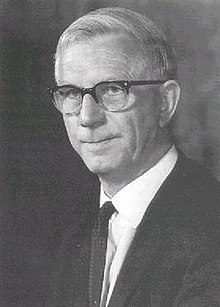Charles Oatley
Sir Charles Oatley | |
|---|---|
 Charles William Oatley (1904-1996) | |
| Born | 14 February 1904 |
| Died | 11 March 1996 (aged 92) |
| Nationality | British |
| Alma mater | St. John's College, Cambridge |
| Known for | Scanning electron microscope |
| Awards | Duddell Medal (1969) Royal Medal (1969) Faraday Medal (1970) Mullard Award (1973) Potts Medal (1989) |
| Scientific career | |
| Fields | Physics Electrical engineering |
| Institutions | Radio Accessories English Electric Valve Company King's College London ADRDE University of Cambridge |
| Academic advisors | Edward Victor Appleton |
| Doctoral students | Haroon Ahmed Alec Broers Thomas Everhart Colin J. R. Sheppard |
Sir Charles William Oatley (14 February 1904 – 11 March 1996) was Professor of Electrical Engineering, University of Cambridge, 1960–1971, and developer of one of the first commercial scanning electron microscopes.[1][2][3] He was also a founder member of the Royal Academy of Engineering.
Biography
[edit]He was born in Frome on Valentine's Day, 14 February 1904. A plaque has been placed on the house at the junction of Badcox Parade and Catherine Hill.[4]
He was educated at Bedford Modern School and St. John's College, Cambridge. He lectured at King's College London for 12 years, until the war. He was a director of the English Electric Valve Company from 1966 to 1985. In 1969, he was elected to the Royal Society.[5]
Oatley also received an Honorary Doctorate from Heriot-Watt University in 1974.[6] In that same year, he was knighted.[7]
He received an Honorary Degree (Doctor of Science) from the University of Bath in 1977.[8] He retired from the English Electric Valve Company in 1985.
He was awarded the Howard N. Potts Medal in 1989. He died on 11 March 1996.
Graduate students
[edit]Oatley and the graduate students he supervised made substantial contributions, particularly to the development of the scanning electron microscope (SEM).[9][10][11]
"A project for a PhD student must provide him with good training and, if he is doing experimental work, there is much to be said for choosing a problem which involves the construction or modification of some fairly complicated apparatus. I have always felt that university research in engineering should be adventurous and should not mind tackling speculative projects."[10]: 12
His students included:
- Thomas Everhart, former President of Caltech
- Alec Broers, former Vice-Chancellor of the University of Cambridge and former president of the Royal Academy of Engineering.
- Haroon Ahmed, former Master of Corpus Christi College, Cambridge and Professor of Microelectronics
References
[edit]- ^ "Oatley, Sir Charles (William), (14 Feb. 1904–11 March 1996), Professor of Electrical Engineering, University of Cambridge, 1960–71, then Emeritus; Fellow of Trinity College, Cambridge, since 1945". WHO'S WHO & WHO WAS WHO. 2007. doi:10.1093/ww/9780199540884.013.U180878. ISBN 978-0-19-954089-1.
- ^ Smith, K. C. A. (1998). "Sir Charles William Oatley, O. B. E. 14 February 1904 – 11 March 1996". Biographical Memoirs of Fellows of the Royal Society. 44: 331–347. doi:10.1098/rsbm.1998.0022. S2CID 62541468.
- ^ Everhart, T. E. (1996). "Persistence pays off: Sir Charles Oatley and the scanning electron microscope" (PDF). Journal of Vacuum Science & Technology B: Microelectronics and Nanometer Structures. 14 (6): 3620. Bibcode:1996JVSTB..14.3620E. doi:10.1116/1.588737.
- ^ "Plaques". 16 June 2016. Retrieved 2 June 2019.
- ^ "Obituary: Professor Sir Charles Oatley". The Independent. 21 March 1996. Retrieved 7 April 2016.
- ^ "Heriot-Watt University Edinburgh: Honorary Graduates". www1.hw.ac.uk. Retrieved 7 April 2016.
- ^ "Biography ~ Sir Charles Oatley". www.purbeckradar.org.uk. Retrieved 7 April 2016.
- ^ "Honorary Graduates 1966 to 1988". University of Bath. Archived from the original on 25 May 2016. Retrieved 19 June 2015.
- ^ Hawkes, Peter W. (2004). Advances in imaging and electron physics: Volume 133, Sir Charles Oatley and the Scanning Electron Microscope (1st ed.). Oxford: Elsevier Academic Press. ISBN 978-0123859853.
- ^ a b Rodenburg, J.M. (1997). Electron microscopy and analysis 1997 : proceedings of the Institute of Physics Electron Microscopy and Analysis Group conference, Cavendish Laboratory, University of Cambridge, 2-5 September 1997. Bristol: Institute of Physics Pub. pp. 11–16. ISBN 978-0750304412. Retrieved 19 June 2015.
- ^ Ratinac, Kyle R. (2008). "Great moment 9: Scanning electron microscopy". In Ratinac, Kyle R. (ed.). 50 great moments : celebrating the golden jubilee of the University of Sydney's Electron Microscope Unit. University of Sydney, N.S.W.: Sydney University Press. pp. 71–81. ISBN 9781920898762. Retrieved 19 June 2015.
External links
[edit]- Charles Oatley: Pioneer of Scanning Electron Microscopy
- The Papers of Sir Charles Oatley held at Churchill Archives Centre accessed 2 July 2008
- Charles Oatley at the Mathematics Genealogy Project
- 1904 births
- 1996 deaths
- People educated at Bedford Modern School
- Alumni of St John's College, Cambridge
- Academics of King's College London
- British physicists
- British electronics engineers
- Fellows of Trinity College, Cambridge
- Fellows of the Royal Academy of Engineering
- Fellows of the Royal Society
- Knights Bachelor
- Officers of the Order of the British Empire
- Royal Medal winners
- People from Frome
- Howard N. Potts Medal recipients
- Engineering professors at the University of Cambridge
